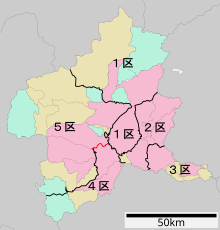Gunma 3rd district
- Machine translation, like DeepL or Google Translate, is a useful starting point for translations, but translators must revise errors as necessary and confirm that the translation is accurate, rather than simply copy-pasting machine-translated text into the English Wikipedia.
- Consider adding a topic to this template: there are already 3,700 articles in the main category, and specifying
|topic=will aid in categorization. - Do not translate text that appears unreliable or low-quality. If possible, verify the text with references provided in the foreign-language article.
- You must provide copyright attribution in the edit summary accompanying your translation by providing an interlanguage link to the source of your translation. A model attribution edit summary is
Content in this edit is translated from the existing Japanese Wikipedia article at [[:ja:群馬県第3区]]; see its history for attribution. - You may also add the template
{{Translated|ja|群馬県第3区}}to the talk page. - For more guidance, see Wikipedia:Translation.
for the Japanese House of Representatives

Gunma 3rd district (群馬県第3区, Gunma-ken dai-san-ku) is a single-member constituency of the House of Representatives in the Diet of Japan. It is located in south-eastern Gunma and consists of Ota, Tatebayashi and Ōra County.
Areas covered
Current district
As of 24 January 2023, the areas covered by this district are as follows:[2]
- Ōta
- Tatebayashi
- Ōra District
As part of the 2022 redistricting, the rest of Ota was transferred back to the district from the 2nd district.
Areas 2013–2022
From the first redistricting in 2013, until the second redistricting in 2022, the areas covered by this district were as follows:[3][4]
- Ōta (excluding Yabuzukahon, Ojima and Nitta)
- Tatebayashi
- Ōra District
As part of the 2013 redistricting, the areas of Yabuzukahon, Ojima and Nitta were transferred to the 2nd district.[4]
Areas from before 2013
From the creation of the district in 1994, until the first redistricting in 2013, the areas covered by this district were as follows:[5]
Elected representatives
| Representative | Party | Years served | Notes | |
|---|---|---|---|---|
| Yoshio Yatsu | LDP | 1996-2009 | ||
| Masaaki Kakinuma | DPJ | 2009-2012 | ||
| Hiroyoshi Sasakawa | LDP | 2012- | Incumbent | |
Election results
References
- ^ "総務省|令和4年9月1日現在選挙人名簿及び在外選挙人名簿登録者数" [Ministry of Internal Affairs and Communications - Number of registered voters as of September 1, 2020]. Ministry of Internal Affairs and Communications (in Japanese). Retrieved 2023-01-24.
- ^ 群馬県 [Gunma Prefecture] (PDF). Ministry of Internal Affairs and Communications (in Japanese). 2022. Retrieved 2023-01-24.
- ^ "衆議院小選挙区選出議員の選挙区間における人口較差を緊急に是正するための公職選挙法及び衆議院議員選挙区画定審議会設置法の一部を改正する法律の一部を改正する法律". www.shugiin.go.jp. Retrieved 2023-01-24.
- ^ a b 群馬県 [Gunma Prefecture] (PDF). Ministry of Internal Affairs and Communications (in Japanese). 2013. Retrieved 2023-01-24.
- ^ "法律第百四号(平六・一一・二五)". www.shugiin.go.jp. Retrieved 2023-01-24.
See also
- v
- t
- e
- SNTV "medium-sized" districts (1947–1993)
- 1
- 2
- 3 (10 Representatives, 4 Councillors)
- Limited voting "large" districts (1946)
- At-large (10 Representatives)
- SNTV "medium-sized" districts (1928–1942)
- 1
- 2 (9 Representatives)
- FPTP/SNTV "small" districts (1920–1924)
- 1
- 2
- 3
- 4
- 5
- 6 (8 Representatives)
- SNTV "large" districts (1902–1917)
- Maebashi city
- Takasaki city
- counties (gunbu) (8 Representatives)
- FPTP/bloc voting "small" districts (1890–1898)
- 1
- 2
- 3
- 4
- 5 (5 Representatives)










